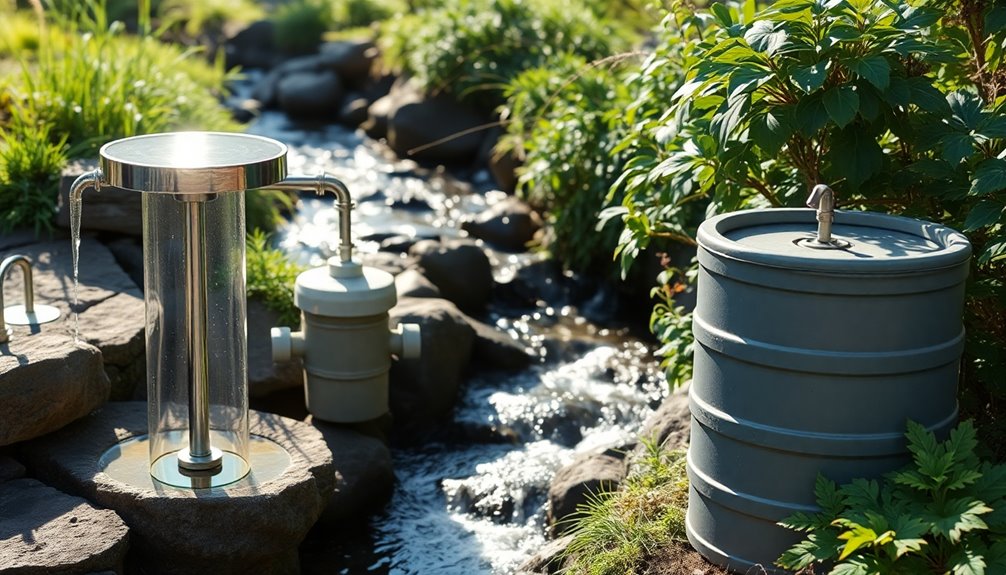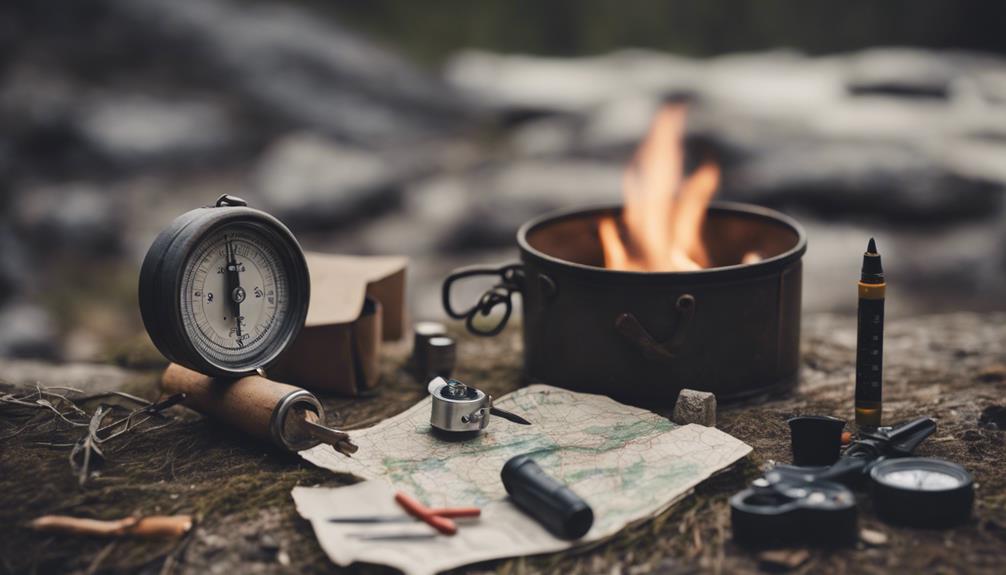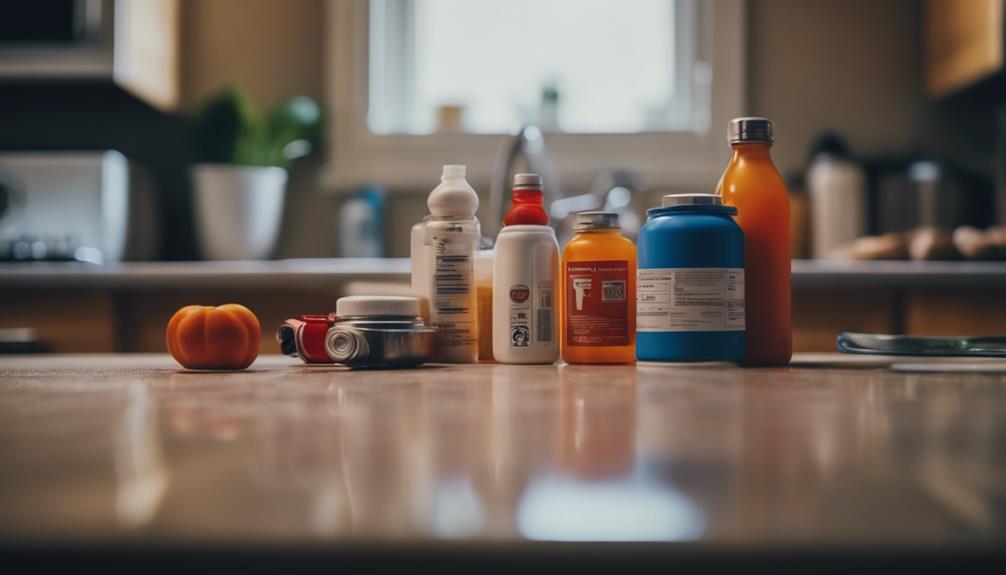Survival boxes are amazing collections packed with essential tools and supplies to help you be ready for any adventure or emergency! Inside, you'll find helpful items like knives, can openers, and water bottles that make survival easier. You might also discover non-perishable foods, first aid kits, and even educational guides to boost your skills. Many services let you customize your box, ensuring it fits your specific needs. Plus, they deliver these goodies right to your door, making it super convenient! Excitingly, there's much more to learn about these fun survival kits that can make your adventures safer and more enjoyable!
Key Takeaways
- Survival boxes provide essential tools and supplies for outdoor adventures and emergencies, ensuring preparedness in various situations.
- Subscription services deliver curated survival gear directly to your doorstep, with no contracts offering flexibility in selection.
- Customizable kits cater to specific geographical needs, incorporating tailored medical supplies and equipment for enhanced usability.
- Educational materials, including guides and tutorials, build survival skills and confidence in handling emergencies effectively.
- The growing market offers diverse boxes, allowing consumers to choose based on specific survival needs and preferences.
Understanding Survival Boxes

When you're exploring the world of survival boxes, it's essential to understand their components and purpose. These boxes are packed with useful tools and supplies that can help you during outdoor adventures or emergencies.
You'll find simple items like knives, can openers, and water bottles, which are perfect for everyday needs. Some boxes even include more complex tools, such as bow drill kits and fire starters, to help you create warmth and cook food.
Many survival boxes come with multi-tools and survival knives. These handy gadgets can serve multiple purposes, making them great for any situation. Each box contains a variety of outdoor tools and gear, including essential survival gear, ensuring you have what you need when it matters most.
You might also discover compact shelters and other specialized items tailored to specific needs, whether you're preparing for wilderness challenges or urban emergencies.
Besides tools, survival boxes often include educational materials. You'll get survival guides and tips for navigating the wild, helping you learn and grow your skills.
With so much variety, each box delivers relevant and valuable items, ensuring you’re always prepared. Understanding survival boxes is your first step toward being ready for anything life throws your way! By having a survival gear box, you can rest assured that you will have the necessary tools and supplies to handle any situation, whether it’s a natural disaster or a hiking trip gone wrong. These boxes are carefully curated to include items such as first-aid supplies, food rations, fire-starting tools, and navigation equipment, giving you peace of mind in any emergency. A survival gear box is an essential investment for anyone who wants to be prepared for the unexpected.
Exploring Subscription Services

Subscription services for survival boxes offer a convenient way to stay equipped for any adventure or emergency. Imagine having hand-picked survival gear delivered right to your doorstep! You won't have to spend hours searching for the right items, which means you can focus on honing your skills instead.
Your first box often ships right away, and after that, you'll receive new supplies regularly, like every month. Plus, there are no contracts, so you can change your plan anytime you want!
These boxes introduce you to exciting new products from lesser-known brands. Each month, you'll discover a curated selection of cool items, like fire starters, flashlights, and tactical knives. Sometimes, they even focus on specific survival themes, keeping things fresh and fun! Each box contains 3 to 6 top-rated survival tools to enhance your preparedness for emergencies.
Many services let you customize your box to fit your needs, so you get exactly what you want. They also include educational materials, like guides and expert tips, to help you learn how to use your gear effectively.
With all these benefits, you'll be ready for anything while enjoying the thrill of surprise!
Key Contents of Survival Boxes

Survival boxes come packed with essential items that can make a real difference in emergencies or outdoor adventures. You'll find non-perishable food like energy bars, canned goods, and dried fruits to keep your energy up.
Remember, it's important to have enough water—aim for at least one gallon per person per day. Don't forget a manual can opener and some fire-starting tools, so you can prepare your meals easily! Additionally, consider including water purification tablets to ensure your drinking water is safe.
First aid kits are crucial, too. Your box should include bandages, antiseptics, and a week's supply of any prescription medications. You'll also want handy tools like scissors and tweezers for minor injuries.
When it comes to staying warm and sheltered, emergency blankets and sleeping bags are lifesavers. Pack extra clothing and rain gear to keep dry.
Lastly, having the right tools can make everything easier. A multi-purpose tool, flashlight, and some navigation aids like a compass can help you find your way.
Don't forget hygiene items like hand sanitizer and moist towelettes! With these key contents in your survival box, you'll be ready for anything that comes your way!
Learning and Skill Development

A well-rounded survival box isn't just about having the right gear—it's also about imparting essential skills that can make all the difference in an emergency. You'll find guides, tips, and tutorials to build your survival knowledge. Waterproof field guides on edible plants, basic first aid, and navigation are super handy if you ever need them! For example, knowing how to identify and harvest wild edibles can provide crucial nutrition in a survival situation.
Imagine flipping through printed waterproof cards that teach you how to build a shelter, start a fire, or signal for help. You can also get flash drives with videos showing you how to filter water, use survival tools, and tie knots. These resources make learning fun and interactive! Additionally, many subscription boxes include educational materials to empower individuals with valuable survival skills. To enhance your preparedness, consider incorporating risk management strategies that can help you navigate emergency situations effectively.
As new tools arrive, you can practice your skills, making sure you know how to use your gear well. Regular deliveries keep you excited and motivated to learn. With checklists and worksheets, you'll practice taking inventory, planning rations, and assessing dangers. This holistic approach means you're not just collecting gear; you're building confidence and competence in handling emergencies.
Customization Options Available

Many outdoor enthusiasts appreciate the ability to customize their survival kits to fit specific needs and environments. You can consider your geographical location and climate to make your kit perfect for you. For example, if you live in a place prone to floods, earthquakes, or wildfires, you'll want to include items that help you during those emergencies.
Think about the terrain, too! Desert and forest survival tools can be very different. It's also important to customize your kit based on personal needs. If you have medical essentials, adding wound care supplies and medications is a great idea. Emergency equipment like thermometers and multi-tools can be lifesavers. Additionally, don't forget to include customizable veterinary prescription pads for efficient medical care. Including sensory toys can help children understand emergency scenarios during role-play, enhancing their preparedness. Understanding the local wildlife can aid in your decision-making when selecting survival tools.
Don't forget to think about the wildlife in your area and pack accordingly!
When it comes to the contents, mix compact and full-size tools for easy use. LED flashlights, signal mirrors, and fire starters should definitely be included.
Lastly, your kit's packaging matters, too! Waterproof boxes or pouches keep everything safe and organized. You can even add labels so you know exactly what's inside.
Customizing your survival kit makes it uniquely yours and ready for any adventure!
Advantages of Subscription Services

Subscription services for survival gear offer unparalleled convenience and peace of mind. Imagine having a box of essential supplies delivered right to your doorstep! You won't need to spend hours researching and shopping for gear. Instead, you can focus on honing your survival skills and planning for emergencies. These boxes arrive every other month, so you'll always have fresh items to add to your collection without the hassle of constant shopping.
What's more, subscription services introduce you to exciting new products and brands. You might discover high-quality gear you'd never find on your own! Each box is curated by experts, ensuring you receive unique and useful items. Plus, the savings can be significant. The total value of the items often exceeds the cost of the subscription, making it a smart choice for your wallet. Additionally, you can trust in the quality of the products, as each item is sourced from vetted manufacturers to guarantee reliability.
Many boxes also come with educational materials that teach you how to use your gear effectively. This way, you're not just collecting tools—you're gaining confidence and skills.
Popular Types of Survival Boxes

Survival boxes come in various types, each catering to different needs and preferences. You can find survival-oriented boxes like BattlBox, which delivers mission-themed gear from brands like TOPS Knives and Zippo. These boxes include handy items like fire starters, med-kits, and shelf-stable foods.
If you're interested in survival skills, check out SHTF Survival curated by Creek Stewart, offering high-quality equipment with guaranteed value. This box is part of the growing trend in the subscription box market, which is projected to grow 14% annually until 2032.
For those who love tactical gear, Clubtac and Crate Club provide exciting military-style boxes filled with top-notch tactical equipment. Gunner Crate is perfect for firearm enthusiasts, while Alpha Outpost mixes tactical and survival gear for double the fun!
If medical supplies are your focus, MedicBox specializes in tactical medical gear, helping you build essential survival kits.
Lastly, general preparedness boxes like Personal Go Bags ensure you have everything you need for emergencies, from food and water to comfort items like games.
With so many options, you can choose a survival box that fits your adventures and keeps you ready for anything!
How to Choose the Right Box

Choosing the right survival box can significantly impact your preparedness for various situations. Start by thinking about where you might need it most. Are you preparing for a wilderness adventure or an urban emergency? Some boxes specialize in specific areas, while others provide a more generalized approach. Make sure the box fits your personal needs!
Next, check the quality of the items inside. You want durable and reliable gear that can help you in tough times. Look for a variety of items that cover different survival aspects. Reviews from other users can give you a good idea of how satisfied people are with what they received. It's also important to consider the multiple uses of the items included, as this enhances overall utility.
Don't forget about educational resources! A good survival box should include guides that teach essential skills, like wilderness navigation and emergency procedures. This knowledge can be lifesaving!
Lastly, think about customization. Some boxes let you tailor them to fit your needs, whether it's size, weight, or specific items. The right survival box should be easy to use and understand, making your preparation fun and exciting!
Happy prepping!
Frequently Asked Questions
How Often Will I Receive My Survival Box Subscription?
You'll receive your subscription box every month!
Once you sign up, your first box usually ships within 3-5 business days. After that, boxes arrive on a specific date, like the 18th of each month.
You'll love that the deliveries are consistent, so you know when to expect your goodies.
Plus, if you ever need to pause or cancel, you can do that anytime.
Enjoy your exciting monthly surprises!
Can I Cancel My Subscription Anytime?
Yes, you can cancel your subscription anytime! It's super easy!
Just send an email to customer care or manage it through your online account settings. Remember, make sure to cancel before the next billing date to avoid charges.
If you change your mind, you'll have a 24-hour window for your first order. So, if you ever need to, you can take control of your subscription with no worries!
Are the Items in the Box Brand New?
Yes, the items in the box are brand new!
Each month, you'll get fresh gear picked just for you. These items are carefully selected, so you can trust they're useful for real survival situations.
You won't find any old or clearance items here. Instead, you'll receive top-rated tools and supplies that are ready to help you stay prepared.
It's all about giving you the best for your adventures!
Do Survival Boxes Cater to Specific Skill Levels?
Yes, survival boxes are designed to cater to different skill levels!
When you're just starting out, you'll find basic gear like multi-tools and water purification supplies. As your skills improve, you can level up to more advanced tools and kits.
Each box can even focus on your specific needs, whether you're into wilderness survival or urban preparedness.
It's all about helping you grow and learn while having fun along the way!
What Is the Average Cost of a Survival Box Subscription?
The average cost of a survival box subscription can vary quite a bit!
For instance, you might find options starting around $35 a month, while some premium boxes could cost over $400 quarterly.
Most subscriptions let you choose between monthly or quarterly plans.
You'll get different items depending on the subscription level you pick, so it's great to explore what fits your needs and budget best.
Enjoy discovering your perfect survival box!
Conclusion
In conclusion, survival boxes are a fun way to prepare for anything life throws at you! With cool items and helpful skills to learn, you can feel ready and confident. Whether you choose a subscription or a one-time box, there's something perfect for everyone. So, explore your options and find the box that excites you the most. You'll be taking a big step towards being prepared, and that's something to celebrate! Happy exploring!










